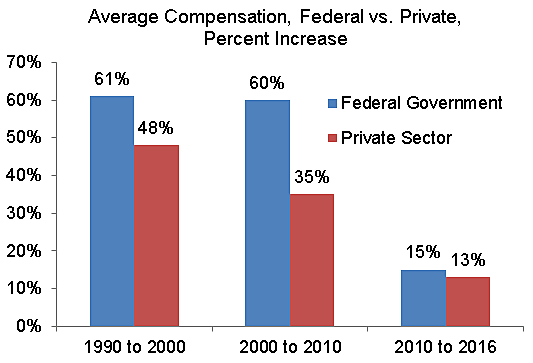The Bureau of Economic Analysis (BEA) has released data on worker compensation for 2016. The data show that wages and benefits for federal-government workers grew faster than for private-sector workers last year. Federal workers now receive 80 percent more compensation, on average, than do workers in the U.S. private sector. I am including federal civilian workers here, not those in the uniformed military.
Average wages for federal workers increased 2.0 percent in 2016, which outpaced the average private increase of 1.3 percent. Federal workers had average wages of $88,809 in 2016, or 49 percent more than the average wages of private workers of $59,458.
However, the federal advantage in overall compensation (wages + benefits) is even larger because of gold-plated federal benefits, such as pension benefits. Total compensation for federal workers increased 2.5 percent last year, on average, more than double the 1.2 percent increase for private workers.
As a consequence, average federal compensation in 2016 was $127,259, which was 80 percent higher than average private compensation of $70,764. The federal advantage of 80 percent is up from just 50 percent in 2000.
The figure below shows that federal compensation grew much faster than private compensation during the 1990s and 2000s. Federal increases slowed during a brief wage freeze under President Obama, but have accelerated again in recent years. Since 2010, federal compensation increases have edged out private increases as a result of the strong growth in federal benefits.
This study examines the latest data and discusses federal compensation issues in more detail.

